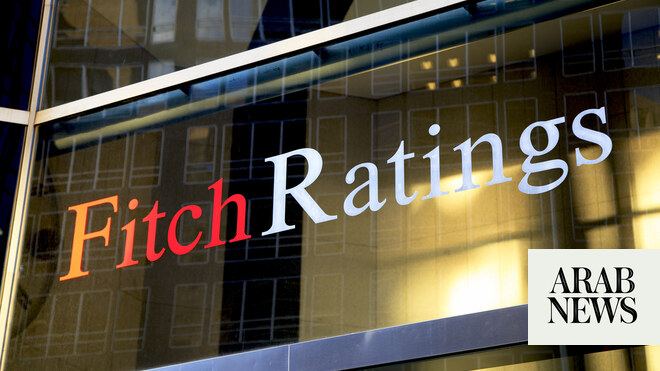Saudi Arabia Leads GCC In US Dollar Debt And Sukuk Issuance, Driving Regional Growth: Fitch

RIYADH: Saudi Arabia holds the largest share of the Gulf Cooperation Council’s debt capital market, with 44.8 percent of outstanding issuances, according to Fitch Ratings.
The US-based agency claims the GCC’s total DCM surpassed the milestone of $1 trillion at the end of January, reflecting a 10 percent year-on-year growth across all currencies.
Saudi Arabia, alongside the UAE, boasts the most mature financial landscape, with both countries leading in sukuk and bond issuances.
Fitch expects the Kingdom to play a pivotal role in driving US dollar debt and sukuk issuance in 2025 and 2026, as Saudi Arabia’s financial institutions and corporations increasingly turn to international debt markets to diversify funding sources, with banks alone anticipated to issue over $30 billion in US dollar-denominated debt this year.
In a different report issued earlier this month, Fitch expected Saudi Arabia’s debt capital market to hit $500 billion by the end of 2025, fueled by economic diversification efforts under Vision 2030.
The DCM, which involves the trading of securities like bonds and promissory notes, serves as a key mechanism for raising long-term capital for both businesses and governments.
In its latest report, Fitch Ratings said: “Falling oil prices could lead to further DCM growth as lower government revenues could lead to increased borrowing.”
It added that the anticipated reduction in US Federal Reserve interest rates in 2025 is expected to create a more favorable funding environment, with GCC central banks likely to follow suit.
Saudi Arabia and the UAE, in particular, are set to benefit from this trend, further solidifying their positions as key regional and global financial hubs.
GCC’s growing role in global debt markets
The GCC accounted for a quarter of all emerging-market US dollar debt issued in 2024, excluding China, with Saudi Arabia, Turkiye and the UAE leading the way..
GCC US dollar DCM issuance surged by 65.8 percent year on year in 2024 to $133.4 billion, underscoring the region’s increasing reliance on international debt markets. New GCC fund passporting regulations could enhance DCM investment opportunities.
Sukuk remained a key financing tool, making up 40 percent of the GCC’s total DCM as of January. Saudi Arabia and its regional counterparts contributed over 40 percent of global sukuk issuance, with GCC volumes soaring 43 percent year on year in 2024 to $87.5 billion.
Notably, nearly 80 percent of Fitch-rated GCC sukuk are investment-grade, with the majority falling within the “A” category, while the remainder is mostly split between AA, BBB, BB, and B ratings.
Most issuers are on “Stable Outlook”’ with the rest mainly on “positive.” Islamic banks played a crucial role in the sukuk ecosystem, both as issuers and investors, reinforcing the Kingdom’s leadership in Islamic finance.
Challenges such as Shariah compliance complexities could impact sukuk structuring and issuance, Fitch warned.
Saudi Arabia and UAE dominate ESG debt market
The GCC’s environmental, social, and governance debt market surpassed $50 billion in outstanding issuances by the end of January, according to the ratings agency.
Saudi Arabia and the UAE led this segment, with ESG debt representing 7.3 percent of the Kingdom’s total dollar debt issuance in 2024.
ESG-debt issuance was also a sizable part — 17 percent — of dollar debt issuance in the UAE.
“ESG debt could help issuers tap demand from ESG-sensitive international investors from the US, Europe and Asia,” Fitch said.
Challenges and future prospects
Despite its rapid expansion, the GCC’s DCM faces hurdles, including a bank-dominated investor base, a preference for bank financing over capital market funding, and limited local-currency debt issuance outside of Saudi Arabia.
The Kingdom’s riyal-denominated market is the most developed in the region but “still has more room for growth,” according to Fitch.
Kuwait became the GCC’s third-largest dollar debt issuer in 2024, with a total of $13.6 billion, led by banks. This is despite the absence of the public debt law, which would enable sovereign borrowing.
Historically, US dollar issuances from Kuwait have been sporadic and rare, with only $11.8 billion issued between 2018 and 2023. “Kuwait’s new government plans to revise liquidity laws to facilitate capital market borrowing, but the timeline is uncertain,” Fitch said.
Public Firms Listed On Muscat Bourse Report 52.6% Surge In Profits
RIYADH: The net profits of public joint companies listed on the Muscat Stock Exchange surged 52.6 percent year on year ... Read more
Riyadh Municipality Unveils New Investment Opportunities Across Key Sectors
JEDDAH: Riyadh has unveiled new investment opportunities for 2025, covering commercial, residential, retail, industrial,... Read more
Global Borrowing Hits $25tn In 2024, Raising Debt Sustainability Fears: OECD
RIYADH: Global borrowing hit a record $25 trillion in 2024, a $10 trillion surge from pre-pandemic levels, sparking conc... Read more
Global Economic Growth To Average At 3.1% In Next 5 Years: IMF Official
RIYADH: Global economic growth is expected to average around 3.1 percent in the next five years, below the pre-pandemi... Read more
Saudi Arabias PIF At Forefront As Gulf SWFs Approach $18tn By 2030
RIYADH: Saudi Arabia’s sovereign wealth fund and five of its regional counterparts are on track to control $18 trillio... Read more
Tabuks Business Journey — A Navigation Of Growth And Vision
RIYADH: A young workforce, strong demand and attractive tourist offerings are helping transform Tabuk into one of Saudi... Read more

